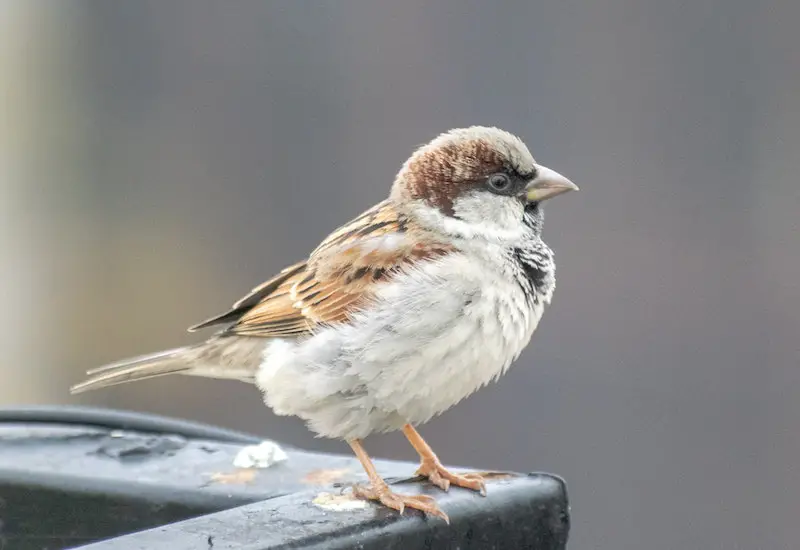There is nothing more frustrating that setting up a purple martin house only to find a few weeks later that other types of birds are trying to take it over. It is something all purple martin landlords have to deal with regularly.
The most common types of birds that you should be cautious of in purple martin houses are the European Starlings and the House Sparrows. These are non-native species and are very aggressive towards the purple martin.
So how can you identify them, and what should you do? My goal is to help you better identify them, but also give some guides on what you might be able to do to help with this nationwide problem we currently have.
What does a European Starling Look Like?
The European Starling is larger than the purple martin. It is recognizable by its spotted feathers and mature starlings frequently have orange beaks. It has shades of purple and blue on its feathers as well.
Here is a picture of a few starlings:

Why is the European Starling So Disliked Among Purple Martin Landlords?
The European Starling is a problem because it is non-native, but it is also a very aggressive bird towards the purple martin. It will come into an existing purple martin unit, kill hatchlings, push eggs from the nest or break them, and kill purple martins inside. Since it is a larger bird, the purple martin is quite defenseless against them, although they will do what they can to protect their young. Warning, there is some graphic content here, but this is evidence of a starling attacking a purple martin nest:
Luckily, it was reported that these purple martins did survive the attack. It is not always the case, and as noted above, it is not uncommon for starlings to kill the young purple martins. Even worse, they have been known to push eggs from the nest, and replace the eggs with their own!
What does a House Sparrow Look Like?
The house sparrow has brown feathers with typically white spots. They have short, sharp beaks and generally a very active bird. You might see these moving frequently in shrubs and trees around a house. They are a common species.
Here is a picture of a house sparrow:

Why is the House Sparrow so Disliked Among Purple Martin Landlords?
Similar to the European Starling, the House Sparrow is aggressive towards the purple martins. They have extremely sharp beaks, which gives them a weapon to fight with. They are able to kill purple martins, despite being smaller. They also are known to poke holes in purple martin eggs, destroying them.
What Should a Landlord Do With Starlings and House Sparrows?
Ultimately, they are a non-native species. So most purple martin landlords that have issues with these species will often attempt to trap them. You can find a trap like this one on Amazon.
The problem with trapping is that you have to be extremely active in watching the trap. Most people trapping will check every few hours what is in the trap because it is also known to catch purple martins regularly. You release the purple martins.
Most landlords that catch starlings and house sparrows will frequently kill them. Since they are taking over purple martin housing and most landlords are trying to grow their colony, keeping these types of birds around will only cause problems down the road.
Will Other Birds Try to Takeover My Purple Martin House?
Absolutely! The downside is that the purple martin is extremely picky about where they nest. If they arrive at your purple martin house early in the spring and it is has old nests from other types of birds in it, they will likely go elsewhere.
It is highly recommended that you clean your purple martin house out before the scouts arrive in the early spring. From there, do regular checks on your purple martin house and remove any nests from other types of birds.
What many purple martin landlords will do is open up a few units at a time. This will hopefully prevent some of the units being taken over, and makes your life a little bit easier in the long run. Once purple martin arrives and if you see any hanging around, I recommend opening it up all the way so you can grow your colony as quickly as possible.
It will take the purple martin several weeks before a pair is formed and a nest is built, so you just want to make sure you keep an eye that no other birds are trying to nest in the other units while your purple martins are working!
How Can I Help Protect My Purple Martins?
Honestly, our purple martin houses are among the best when it comes to protection for the purple martin. They have fairly deep units in the house, making it difficult for owls and raccoons to reach in and grab eggs.
The primary protection though is known as “SREB” doors. These are generally crescent in shape. They are protection primarily against the Starlings. Since the Starling is larger, stands a bit taller, the crescent shaped doors make it very difficult for larger starlings to enter. They are known as resistant doors, because smaller starlings still may be able to enter. However, they do a pretty good job of keeping the starling at bay from the eggs and hatchlings.
Unfortunately, with the house sparrow being so small, they are still able to enter the units. There is nothing out there, outside of trapping them, to keep them away from the martins. They can be a common problem in some areas, but the starling is likely the bigger threat for most older purple martin colonies and houses that do not have the SREB doors.
If you are interested, I have written an article about protecting your purple martin colony, which is primarily related to the ground predators that you should also be cautious of.
